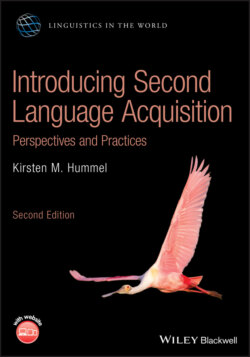Читать книгу Introducing Second Language Acquisition - Kirsten M. Hummel - Страница 32
2.6 summing up
ОглавлениеThis chapter has pointed out considerable evidence that innate structures offer a reasonable explanation for the rapidity of development and universality of stages that characterize L1 acquisition. Babbling occurs early on, and at approximately the first year mark, the child's first recognizable word may appear. At around the 50‐word vocabulary mark, children appear to begin to string two words together, and vocabulary and grammatical development accelerates thereafter. Children's grammatical development has been measured in terms of MLU, calculated in terms of morphemes per utterance. Brown (1973) found that children differ in rate of MLU development, although they acquire forms in a similar order. It has also been established that children tend to make typical errors, including overgeneralizing rules, as in using “mouses” instead of “mice.” They also may go through a period in which word meanings are overextended (“dog” for all four‐footed animals) and/or underextended (“dog” only for the family pet).
There are considerable differences in learning a first language as an infant and learning a second language after a first language has been acquired. Many of the differences are related to age and cognitive developmental factors. Others are related to the very fact that for L2 acquisition one language is already available to enable basic communication and the expression of needs and desires. On the other hand, despite these remarkable differences, there is much about the two processes that is similar: similar patterns of development, similar errors, similar strategies that mark developmental stages. As we continue to explore second language acquisition, an awareness of these differences and similarities should permit a better understanding of the challenges faced by the second language learner.
